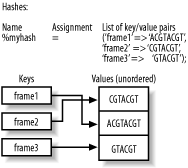A.7 Hashes
A hash (also called an associative array) is a collection of zero or more pairs of scalar values, called keys and values. The values are indexed by the keys. An array variable begins with the % sign followed by a legal variable name. For instance, possible hash variable names are:
%hash1 %genes_by_name
You can assign a value to a key with a simple assignment statement. For example, say you have a hash called %baseball_stadiums and a key Phillies to which you want to assign the value Citizens Bank Park. This statement accomplishes the assignment:
$baseball_stadiums{'Phillies'} = 'Citizens State Bank';
Note that a single hash value is referenced by a $ instead of a % at the beginning of the hash name; this is similar to the way you reference individual array values using a $ instead of a @.
You can assign several keys and values to a hash by placing their scalar values in a list separated by commas and surrounded by a pair of parentheses. Each successive pair of scalars becomes a key and a value in the hash. For instance, you can assign a hash the empty list:
%hash = ( );
You can also assign one or more scalar key/value pairs:
%genes_by_name = ('gene1', 'AACCCGGTTGGTT', 'gene2', 'CCTTTCGGAAGGTC');
There is an another way to do the same thing, which makes the key/value pairs more readily apparent. This accomplishes the same thing as the preceding example:
%genes_by_name = (
'gene1' => 'AACCCGGTTGGTT',
'gene2' => 'CCTTTCGGAAGGTC'
);
To get the value associated with a particular key, precede the hash name with a $ and follow it with a pair of curly braces containing the scalar value of the key:
$genes_by_name{'gene1'}
This returns the value 'AACCCGGTTGGTT', given the value previously assigned to the key 'gene1' in the hash %genes_by_name. Figure A-2 shows a hash with three keys.
Figure A-2. Schematic of a hash

You can get an array of all the keys in a hash with the operator "keys", and you can get an array of all the values in a hash with the operator "values".
The arrays you get won't be sorted. Here's an example:
%h = ( 'one' => 'for the money',
'two' => 'for the show',
'three' => 'to get ready'
);
@keys = keys %h;
@values = values %h;
print "@keys\n@values\n";
gives the output:
three one two
to get ready for the money for the show.
You can make a reference to a hash by preceding it with a backslash; you dereference it by preceding the reference with a percent sign % for the entire hash or with an extra dollar sign $ for an individual value of some hash key:
%h = ( 'one' => 'for the money',
'two' => 'for the show',
'three' => 'to get ready'
);
$href =  h;
print $href, "\n";
print $$href{'two'}, "\n";
foreach $key ( keys %$href ) {
print "key = $key value = $$href{$key}\n";
}
h;
print $href, "\n";
print $$href{'two'}, "\n";
foreach $key ( keys %$href ) {
print "key = $key value = $$href{$key}\n";
}
gives the output:
HASH(0x811d1e0) for the show key = three value = to get ready key = one value = for the money key = two value = for the show
You can also define a hash as an anonymous hash. An anonymous hash isn't saved in a named hash variable; it's a reference to hash data, and can only be saved in a reference. It is initialized within curly brackets:
$anonhash = { 'one' => 'first',
'two' => 'second',
'three' => 'third'
};
foreach $key ( keys %$anonhash ) {
print "key = $key value = $$anonhash{$key}\n";
}
gives the (unsorted) output:
key = three value = third key = one value = first key = two value = second







